Pontoon bridge
|
U.S. Army troops cross the Rhine on a heavy pontoon bridge, March, 1945[1] | |
| Carries | Pedestrian, automobile, truck |
|---|---|
| Span range | Short to long |
| Material | Various: steel, concrete, boats, barrels, plastic floats, appropriate decking material |
| Movable | Generally not, but may have movable sections for watercraft passage |
| Design effort | low |
| Falsework required | No |
A pontoon bridge (or ponton bridge), also known as a floating bridge, uses floats or shallow-draft boats to support a continuous deck for pedestrian and vehicle travel. The buoyancy of the supports limits the maximum load they can carry.
Most pontoon bridges are temporary, used in wartime and civil emergencies. Permanent floating bridges are useful for sheltered water-crossings where it is not considered economically feasible to suspend a bridge from anchored piers. Such bridges can require a section that is elevated, or can be raised or removed, to allow waterborne traffic to pass.
Pontoon bridges have been in use since ancient times and have been used to great advantage in many battles throughout history, among them the Battle of Garigliano, the Battle of Oudenarde, the crossing of the Rhine during World War II, and during the Iran–Iraq War Operation Dawn 8.
Definition
A pontoon bridge is a collection of specialized, shallow draft boats or floats, connected together to cross a river or canal, with a track or deck attached on top. The water buoyancy supports the boats, limiting the maximum load to the total and point buoyancy of the pontoons or boats.[2] The supporting boats or floats can be open or closed, temporary or permanent in installation, and made of rubber, metal, wood, or concrete. The decking may be temporary or permanent, and constructed out of wood, modular metal, or asphalt or concrete over a metal frame.
Etymology
The spelling "ponton" in English dates from at least 1870.[3] The use continued in references found in U.S. patents during the 1890s.[4][5][6] It continued to be spelled in that fashion through World War II,[7] when temporary floating bridges were used extensively throughout the European theatre. U.S. combat engineers commonly pronounced the word "ponton" rather than "pontoon" and U.S. military manuals spelled it using a single 'o'.[8] The original word was derived from Old French ponton, from Latin ponto ("ferryboat"), from pons ("bridge").[9]
Design


When designing a pontoon bridge, the civil engineer must take into consideration the Archimedes' principle looking at the maximum amount of load that it is intended to support. Each pontoon can support a load equal to the mass of the water that it displaces, but this load also includes the mass of the bridge itself. If the maximum load of a bridge section is exceeded, one or more pontoons become submerged and will proceed to sink. The roadway across the pontoons must also be able to support the load, yet be light enough not to limit their carrying capacity.[10]
Survey to determine the best location. The connection to shore often causes problems, requiring the design of approaches[11] that are not too steep, keep the bank from crumbling and when tidal, can be used at all states of the tide.
Floating bridges were typically constructed using wood. Such a wooden floating bridge could be built in a series of sections, starting from an anchored point on the shore. Pontoons were formed using boats; several barrels lashed together; rafts of timbers, or some combination of these. Each bridge section consisted of one or more pontoons, which were maneuvered into position and then anchored, using underwater, land based and/or overhead anchors. These pontoons were then linked together using wooden stringers called balks. The balks were then covered by a series of cross planks called chesses to form a road surface,[12] and the chesses were held in place with side guard rails. More modern pontoons use pre-fabricated floating structures[13]
The expected life of a pontoon bridge is normally short, from a few hours, to weeks or months, and the design has to take account of the expected life. Some bridges have been designed and survived much longer. In Hobart a long pontoon bridge built in 1943 was only replaced after 21 years.[14] The fourth Galata Bridge that spans the Golden Horn in Istanbul, Turkey was built in 1912 and operated for 80 years.
Precautions are needed to protect a pontoon bridge from becoming damaged. The bridge can be dislodged or inundated whenever the load limit of the bridge is exceeded. A pontoon bridge can also become overloaded when one section of the bridge is weighted down much more heavily than the other parts. The bridge can be induced to sway or oscillate in a hazardous manner because of the regular stride of a group of soldiers, or from other types of repeated loads. Flotsam and heavy floating objects can also accumulate on the pontoons, increasing the drag from river current and potentially damaging the bridge. Fire, storms, floods and ice are harder to protect against. See below for floating pontoon failures and disasters.
Historic uses
.jpg)
Ancient China
In ancient China, the Zhou Dynasty Chinese text of the Shi Jing (Book of Odes) records that King Wen of Zhou was the first to create a pontoon bridge in the 11th century BC. However, the historian Joseph Needham has pointed out that in all likely scenarios, the temporary pontoon bridge was invented during the 9th or 8th century BC in China, as this part was perhaps a later addition to the book (considering how the book had been edited up until the Han Dynasty, 202 BC – 220 AD). Although earlier temporary pontoon bridges had been made in China, the first secure and permanent ones (and linked with iron chains) in China came first during the Qin Dynasty (221–207 BC). The later Song Dynasty (960–1279 AD) Chinese statesman Cao Cheng once wrote of early pontoon bridges in China (spelling of Chinese in Wade-Giles format):
The Chhun Chhiu Hou Chuan says that in the 58th year of the Zhou King Nan (257 BC), there was invented in the Qin State the floating bridge (fou chhiao) with which to cross rivers. But the Ta Ming ode in the Shih Ching (Book of Odes) says (of King Wen) that he 'joined boats and made of them a bridge' over the River Wei. Sun Yen comments that this shows that the boats were arranged in a row, like the beams (of a house) with boards laid (transversely) across them, which is just the same as the pontoon bridge of today. Tu Yu also thought this. ... Cheng Khang Chheng says that the Zhou people invented it and used it whenever they had occasion to do so, but the Qin people, to whom they handed it down, were the first to fasten it securely together (for permanent use).[15]
During the Eastern Han Dynasty (25–220 AD), the Chinese created a very large pontoon bridge that spanned the width of the Yellow River. There was also the rebellion of Gongsun Shu in 33 AD, where a large pontoon bridge with fortified posts was constructed across the Yangtze River, eventually broken through with ramming ships by official Han troops under Commander Cen Peng. During the late Eastern Han into the Three Kingdoms period, during the Battle of Chibi in 208 AD, the Prime Minister Cao Cao once linked the majority of his fleet together with iron chains, which proved to be a fatal mistake once he was thwarted with a fire attack by Sun Quan's fleet.
The armies of Emperor Taizu of Song had a large pontoon bridge built across the Yangtze River in 974 in order to secure supply lines during the Song Dynasty's conquest of the Southern Tang.[16]
On October 22, 1420, Ghiyasu'd-Din Naqqah, the official diarist of the embassy sent by the Timurid ruler of Persia, Mirza Shahrukh (r. 1404–1447), to the Ming Dynasty of China during the reign of the Yongle Emperor (r. 1402–1424), recorded his sight and travel over a large floating pontoon bridge at Lanzhou (constructed earlier in 1372) as he crossed the Yellow River on this day. He wrote that it was:
... composed of twenty three boats, of great excellence and strength attached together by a long chain of iron as thick as a man's thigh, and this was moored on each side to an iron post as thick as a man's waist extending a distance of ten cubits on the land and planted firmly in the ground, the boats being fastened to this chain by means of big hooks. There were placed big wooden planks over the boats so firmly and evenly that all the animals were made to pass over it without difficulty.[17]
Greco-Roman era


The Greek writer Herodotus in his Histories, records several pontoon bridges. The Persian Emperor Darius used a 2 kilometres (1.2 mi) pontoon bridge to cross the Bosphorus and Emperor Caligula built a 2 miles (3.2 km) bridge at Baiae in 37 AD. For Emperor Darius I The Great of Persia (522–485 BC), the Greek Mandrocles of Samos once engineered a pontoon bridge that stretched across the Bosporus, linking Asia to Europe, so that Darius could pursue the fleeing Scythians as well as move his army into position in the Balkans to overwhelm Macedon. Other spectacular pontoon bridges were Xerxes' Pontoon Bridges across the Hellespont by Xerxes I in 480 BC to transport his huge army into Europe:
and meanwhile other chief-constructors proceeded to make the bridges; and thus they made them: They put together fifty-oared galleys and triremes, three hundred and sixty to be under the bridge towards the Euxine Sea, and three hundred and fourteen to be under the other, the vessels lying in the direction of the stream of the Hellespont (though crosswise in respect to the Pontus), to support the tension of the ropes. They placed them together thus, and let down very large anchors, those on the one side towards the Pontus because of the winds which blow from within outwards, and on the other side, towards the West and the Egean, because of the South-East and South Winds. They left also an opening for a passage through, so that any who wished might be able to sail into the Pontus with small vessels, and also from the Pontus outwards. Having thus done, they proceeded to stretch tight the ropes, straining them with wooden windlasses, not now appointing the two kinds of rope to be used apart from one another, but assigning to each bridge two ropes of white flax and four of the papyrus ropes. The thickness and beauty of make was the same for both, but the flaxen ropes were heavier in proportion, and of this rope a cubit weighed one talent. When the passage was bridged over, they sawed up logs of wood, and making them equal in length to the breadth of the bridge they laid them above the stretched ropes, and having set them thus in order they again fastened them above. When this was done, they carried on brushwood, and having set the brushwood also in place, they carried on to it earth; and when they had stamped down the earth firmly, they built a barrier along on each side, so that the baggage-animals and horses might not be frightened by looking out over the sea.[18]
The late Roman writer Vegetius, in his work De Re Militari, wrote:
But the most commodious invention is that of the small boats hollowed out of one piece of timber and very light both by their make and the quality of the wood. The army always has a number of these boats upon carriages, together with a sufficient quantity of planks and iron nails. Thus with the help of cables to lash the boats together, a bridge is instantly constructed, which for the time has the solidity of a bridge of stone.[19]
The emperor Caligula is said to have ridden a horse across a pontoon bridge stretching two miles between Baiae and Puteoli while wearing the armour of Alexander the Great to mock a soothsayer who had claimed he had "no more chance of becoming emperor than of riding a horse across the Bay of Baiae". Caligula's construction of the bridge cost a massive sum of money and added to discontent with his rule.
Middle Ages
Although pontoons declined in use during the European Middle Ages, they were still used alongside regular boats to span rivers during campaigns, or to link communities which lacked resources to build permanent bridges.[20] According to the chronicles, the earliest floating bridge across the Dnieper River in the area was built in the 1115. It was located near Vyshhorod, Kiev.
Towards the end of the medieval period, pontoon bridges became once again a standard part of military engineering (e.g. Battle of Calliano (1487)).
Early modern period

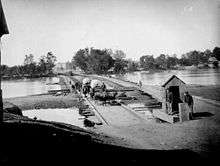
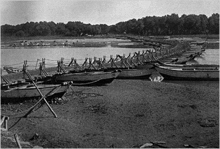
In the 1670s, the French devised the copper pontoon; after this point, rivers and canals ceased to present significant obstacles.[21] The early modern period in pontoon use was dominated by the wars of the 18th and 19th centuries during which the art and science of pontoon bridging barely changed. This however did not stop all innovation, in 1708 a Swedish army used a leather pontoon bridge to cross a river before the Battle of Holowczyn
During the Peninsular War the British army transported "tin pontoons"[22]:353 that were lightweight and could be quickly turned into a floating bridge.
Lt Col Charles Pasley of the Royal School of Military Engineering at Chatham England developed a new form of pontoon which was adopted in 1817 by the British Army. Each pontoon was split into two halves, and the two pointed ends could be connected together in locations with tidal flow. Each half was enclosed, reducing the risk of swamping, and the sections bore multiple lashing points.[23]
The "Palsey Pontoon" lasted until 1836 when it was replaced by the "Blanshard Pontoon" which comprised tin cylinders 3 feet wide and 22 feet long, placed 11 foot apart, making the pontoon very buoyant.[23] The pontoon was tested with the Palsey Pontoon on the Medway.[24]
An alternative proposed by Charles Pasley comprised two copper canoes, each 2 foot 8 inches wide and 22 foot long and coming in two sections which were fastened side by side to make a double canoe raft. Copper was used in preference to fast-corroding tin. Lashed at 10 foot centres, these were good for cavalry, infantry and light guns; lashed at 5 foot centres, heavy cannon could cross. The canoes could also be lashed together to form rafts. One cart pulled by two horse carried two half canoes and stores.[25]
A comparison of pontoons used by each nations army shows that almost all were open boats coming in one, two or even three pieces, mainly wood, some with canvas and rubber protection, Belgium used an iron boat. America used cylinders split into three.[23]
In 1862 the Union forces commanded by Major General Ambrose Burnside were stuck on the wrong side of the Rappahannock River at Fredericksburg for lack of the arrival of the Pontoon train resulting in severe losses.[26]:115 [27] The report of this disaster resulted in Britain forming and training a Pontoon Troop of Engineers.[26]:116–8
During the American Civil War various forms of pontoon bridges were tried and discarded. Wooden pontoons and India rubber bag pontoons shaped like a torpedo proved impractical until the development of cotton-canvas covered pontoons, which required more maintenance but were lightweight and easier to work with and transport.[27] From 1864 a lightweight design known as Cumberland Pontoons, a folding boat system, were widely used during the Atlanta Campaign to transport soldiers and artillery across rivers in the South.
In 1872 at a military review before Queen Victoria, a pontoon bridge was thrown across the River Thames at Windsor, Berkshire, where the river was 250 feet (76 m) wide. The bridge, comprising 15 pontoons held by 14 anchors, was completed in 22 minutes and then used to move five battalions of troops across the river. It was removed in 34 minutes the next day.[26]:122–124
The British Blanshard Pontoon stayed in British use until the late 1870s, when it was replaced by the "Blood Pontoon". The Blood Pontoon returned to the open boat system, which enabled use as boats when not needed as pontoons. Side carrying handles helped transportation.[23] The new pontoon proved strong enough to support loaded elephants and siege guns as well as military traction engines.[26]:119
Early 20th Century
The British Blood Pontoon MkII, which took the original and cut it into two halves, was still in use with the British Army in 1924.[23]
The First World War saw developments on "trestles" to form the link between a river bank and the pontoon bridge. Some infantry bridges in WW1 used any material available, including petrol cans as floatation devices.[23]
The Kapok Assault Bridge for infantry was developed for the British Army, using kapok filled canvas float and timber foot walks. America created their own version.[23]
Folding Boat Equipment was developed in 1928 and went through several versions until it was used in WW2 to compliment the Bailey Pontoon. It had a continuous canvas hinge and could fold flat for storage and transportation. When assembled it could carry 15 men and with two boats and some additional toppings it could transport a 3-ton truck. Further upgrades during WW2 resulted in it moving to a Class 9 bridge.[23]
World War II
Pontoon bridges were used extensively during World War II, mainly in the European Theater of Operations. The United States was the principal user, with Britain next.
United States of America
In the United States, combat engineers were responsible for bridge deployment and construction. These were formed principally into Engineer Combat Battalions, which had a wide range of duties beyond bridging, and specialized units, including Light Ponton Bridge Companies, Heavy Ponton Bridge Battalions, and Engineer Treadway Bridge Companies; any of these could be organically attached to infantry units or directly at the divisional, corps, or army level.
American Engineers built three types of floating bridges: M1938 infantry footbridges, M1938 ponton bridges, and M1940 treadway bridges, with numerous subvariants of each. These were designed to carry troops and vehicles of varying weight, using either an inflatable pneumatic ponton or a solid aluminum-alloy ponton bridge.[5] Both types of bridges were supported by pontons (known today as "pontoons") fitted with a deck built of balk, which were square, hollow aluminum beams.[28]
- American Light Ponton Bridge Company
An Engineer Light Ponton Company consisted of three platoons: two bridge platoons, each equipped with one unit of M3 pneumatic bridge, and a lightly equipped platoon which had one unit of footbridge and equipment for ferrying.[29] The bridge platoons were equipped with the M3 pneumatic bridge, which was constructed of heavy inflatable pneumatic floats and could handle up to 10 short tons (9.1 t); this was suitable for all normal infantry division loads without reinforcement, greater with.
- American Heavy Ponton Bridge Battalion
A Heavy Ponton Bridge Battalion was provided with equipage required to provide stream crossing for heavy military vehicles that could not be supported by a light ponton bridge. The Battalion had two lettered companies of two bridge platoons each. Each platoon was equipped with one unit of heavy ponton equipage. The battalion was an organic unit of army and higher echelons. The M1940 could carry up to 25 short tons (23 t).[29][30] The M1 Treadway Bridge could support up to 20 short tons (18 t). The roadway, made of steel, could carry up to 50 short tons (45 t), while the center section made of 4 inches (100 mm) thick plywood could carry up to 30 short tons (27 t). The wider, heavier tanks used the outside steel treadway while the narrower, lighter jeeps and trucks drove across the bridge with one wheel in the steel treadway and the other on the plywood.[31][32]
- American Engineer Treadway Bridge Company
An Engineer Treadway Bridge Company consisted of company headquarters and two bridge platoons. It was an organic unit of the armored force, and normally was attached to an Armored Engineer Battalion. Each bridge platoon transported one unit of steel treadway bridge equipage for construction of ferries and bridges in river-crossing operations of the armored division.[29] Stream-crossing equipment included utility powerboats, pneumatic floats, and two units of steel treadway bridge equipment, each of which allowed the engineers to build a floating bridge about 540 feet (160 m) in length.[29]
- Materials and equipment
- Pneumatic ponton
The United States Army Corps of Engineers designed a self-contained bridge transportation and erection system. The Brockway model B666 6 short tons (5.4 t) 6x6 truck chassis (also built under license by Corbitt and White) was used to transport both the bridge's steel and rubber components. A single Brockway truck could carry material for 30 feet (9.1 m) of bridge, including two pontons, two steel saddles that were attached to the pontons, and four treadway sections.[33] Each treadway was 15 feet (4.6 m) long with high guardrails on either side of the 2 feet (0.61 m) wide track.[33]
The truck was mounted with a 4 short tons (3.6 t) hydraulic crane that was used to unload the 45 inches (110 cm) wide steel treadways. A custom designed twin boom arm was attached to rear of the truck bed and helped unroll and place the heavy inflatable rubber pontoons upon which the bridge was laid. The 220 inches (560 cm) wheelbase chassis included a 25,000 pounds (11,000 kg) front winch and extra-large air-brake tanks that also served to inflate the rubber pontoons before they were placed in the water.[34]
A pneumatic float was made of rubberized fabric separated by bulkheads into 12 airtight compartments and inflated with air.[35] The pneumatic float consisted of an outer perimeter tube, a floor, and a removable center tube. The 18 short tons (16 t) capacity float was 8 feet 3 inches (2.51 m) wide, 33 feet (10 m) long, 2 feet 9 inches (0.84 m) deep.[36]
- Solid ponton
Solid aluminum-alloy pontons were used in place of pneumatic floats to support heavier bridges and loads.[28] They were also pressed into service for lighter loads as needed.
- Treadway
A treadway bridge was a multi-section, prefabricated floating steel bridge supported by pontoons carrying two metal tracks (or "tread ways") forming a roadway. Depending on its weight class, the treadway bridge was supported either by heavy inflatable pneumatic pontons or by aluminum-alloy half-pontons. The aluminum half-pontons were 29 feet 7 inches (9.02 m) long overall, 6 feet 11 inches (2.11 m) wide at the gunwales, and 3 feet 4 inches (1.02 m) deep except at the bow where the gunwale was raised. The gunwales were 6 feet 8 inches (2.03 m) center-to-center. At 6 inches (150 mm) inches freeboard, the half-ponton has a displacement of 26,500 pounds (12,000 kg). The sides and bow of the half-ponton sloped inward, permitting two or more to be nested for transporting or storing.[37]
A treadway bridge could be built of floating spans or fixed spans.[38] An M2 treadway bridge was designed to carry artillery, heavy duty trucks, and medium tanks up to 40 short tons (36 t).[30] This could be of any length, and was what was used over major river obstacles such as the Rhine and Moselle. Doctrine stated that it would take 5 1/2 hours to place a 362-foot section of M2 treadway during daylight and 7 1/2 hours at night. Pergrin says that in practise 50 ft/hour of treadway construction was expected, which is a little slower than the speed specified by doctrine.[39]
By 1943, combat engineers faced the need for bridges to bear weights of 35 tons or more. To increase weight bearing capacity, they used bigger floats to add buoyancy. This overcame the capacity limitation, but the larger floats were both more difficult to transport to the crossing site and requiring more and larger trucks in the divisional and corps trains.[40]
Britain

Donald Bailey invented the Bailey Bridge, which was made up of modular, pre-fabricated steel trusses capable of carrying up to 40 short tons (36 t) over spans up to 180 feet (55 m). While typically constructed point-to-point over piers, they could be supported by pontoons as well.[39]
The Bailey Bridge was used for the first time in 1942. The first version put into service was a Bailey Pontoon and Raft with a 30 feet (9.1 m) single-single Bailey bay supported on two pontoons. A key feature of the Bailey Pontoon was the use of a single span from the bank to the bridge level which eliminated the need for bridge trestles.[23]
For lighter vehicle bridges the Folding Boat Equipment could be used and the Kapok Assault Bridge was available for infantry.[23]
An open sea type of pontoon, another British war time invention, known by their code names, the Mulberry harbours floated across the English Channel to provide harbours for the June 1944 Allied invasion of Normandy. The dock piers were code named "Whale". These piers were the floating roadways that connected the "Spud" pier heads to the land. These pier heads or landing wharves, at which ships were unloaded each consisted of a pontoon with four legs that rested on the sea bed to anchor the pontoon, yet allowed it to float up and down freely with the tide. "Beetles" were pontoons that supported the "Whale" piers. They were moored in position using wires attached to "Kite" anchors which were also designed by Allan Beckett. These anchors had a high holding power[41] as was demonstrated in D+13 Normandy storm where the British Mulberry survived most of the storm damage whereas the American Mulberry, which only had 20% of its Kite Anchors deployed, was destroyed.
Soviet Union
Amongst other pontoon bridges designed by the Soviet Union during World War II. The PMP Floating Bridge design enables for a quick assembly of its parts.[42] It has a carrying capacity of 60 tons.[42]
Gallery
- Pontoon bridges during World War II
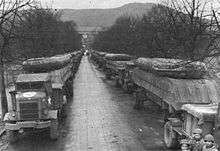 Smaller, lighter pneumatic pontons piggy-backed upon large aluminum heavy pontons for combined transport
Smaller, lighter pneumatic pontons piggy-backed upon large aluminum heavy pontons for combined transport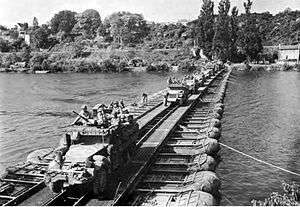 Pneumatic pontons support a treadway bridge
Pneumatic pontons support a treadway bridge Pneumatic pontons being carried by heavy 6×6 transports
Pneumatic pontons being carried by heavy 6×6 transports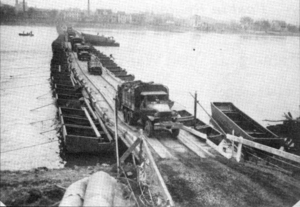 Heavy ponton bridge supported by large aluminum pontons
Heavy ponton bridge supported by large aluminum pontons Treadway bridge atop pneumatic pontons
Treadway bridge atop pneumatic pontons Infantry support bridge supported by light aluminum pontoons
Infantry support bridge supported by light aluminum pontoons Treadway being installed using truck mounted crane
Treadway being installed using truck mounted crane Infantry footbridge supported by pontons
Infantry footbridge supported by pontons Treadway style infantry support bridge built on light aluminum pontons
Treadway style infantry support bridge built on light aluminum pontons M2 Treadway bridge supported by pneumatic floats
M2 Treadway bridge supported by pneumatic floats British troops crossing the Seine at Vernon, France on 28 August 1944
British troops crossing the Seine at Vernon, France on 28 August 1944 Heavy ponton bridge
Heavy ponton bridge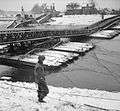 Bailey Bridge supported by pontons
Bailey Bridge supported by pontons German engineers building a pontoon bridge across the Prut River during the advance towards Uman, 1941
German engineers building a pontoon bridge across the Prut River during the advance towards Uman, 1941
Modern military uses
Pontoon bridges were extensively used by both the armies and civilians throughout the first half of the 20th century and both World Wars. The longest military pontoon bridge ever constructed across a river was built in 1995 by the 502nd and 38th Engineer Companies of the U.S. Army's 130th Engineer Brigade, and the 586th Engineer Company from Ft. Benning GA, as part of IFOR. It was assembled under adverse weather conditions across the Sava near Županja (between Croatia and Bosnia), and had a total length of 2,034 feet (620 m). It was dismantled in 1996.
Yugoslav wars
During the Yugoslav wars of the 1990s, the Maslenica Bridge was destroyed and a short pontoon bridge was built by Croatian civilian and military authorities in July 1993 over a narrow sea outlet in the town of Maslenica, after the territory was retaken from Serbian Krajina. Between 1993 and 1995 the pontoon served as one of the two operational land links toward Dalmatia and Croat- and Bosnian Muslim-held areas of Bosnia-Herzegovina that did not go through Serb-held territory.[43]
Invasion of Iraq
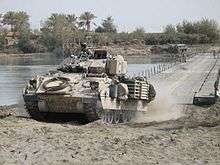
The United States Army developed the Assault Float Ribbon Bridge that was used by the 299th Multi-role Bridge Company, USAR on the Euphrates River at Objective Peach near Al Musayib on the night of 3 April 2003. A 185-meter Assault Float Bridge was built to support retrograde operations because of the heavy-armor traffic crossing a partially destroyed highway span.[44]
"By dawn on 4 April 2003, the 299th Engineer Company had emplaced a 185-meter long Assault Float Bridge—the first time in history that a bridge of its type was built in combat."[45] This took place during the 2003 invasion of Iraq by American and British forces. That same night, the 299th also constructed a 40-metre (130 ft) single-story Medium Girder Bridge to patch the damage done to the highway span. The 299th was part of the U.S. Army's 3rd Infantry Division as they crossed the border into Iraq on 20 March 2003.
Railway pontoon bridge
Russia has developed a revolutionary railroad pontoon bridge the MLZhVT, that can also be used as a road bridge.[46][47]
Failures and disasters
The Saint Isaac's Bridge across Neva river in St.Petersburg suffered two disasters, one natural, a gale in 1733, and then a fire in 1916.
Floating bridges can be vulnerable to inclement weather, especially strong winds. The U.S. state of Washington is home to some of the longest permanent floating bridges in the world, and two of these failed in part due to strong winds.[48]
In 1979, the longest floating bridge crossing salt water, the Hood Canal Bridge, was subjected to winds of 80 miles per hour (130 km/h), gusting up to 120 MPH. Waves of 10–15 feet (3.0–4.6 m) battered the sides of the bridge, and within a few hours the western 3⁄4 mile (1.2 km) of the structure had sunk.[49] It has since been rebuilt.
In 1990, the 1940 Lacey V. Murrow Memorial Bridge was closed for renovations. Specifically, the sidewalks were being removed to widen the traffic lanes to the standards mandated by the Interstate Highway System. Engineers realized that jackhammers could not be employed to remove the sidewalks without risking compromising the structural integrity of the entire bridge. As such, a unique process called hydrodemolition was employed, in which powerful jets of water are used to blast away concrete, bit by bit. The water used in this process was temporarily stored in the hollow chambers in the pontoons of the bridge in order to prevent it from contaminating the lake. During a week of rain and strong winds, the watertight doors were not closed and the pontoons filled with water from the storm, in addition to the water from the hydrodemolition. The inundated bridge broke apart and sank.[49] The bridge was rebuilt in 1993.
A minor disaster occurs if anchors or connections between the pontoon bridge segments fail. This may happen because of overloading, extreme weather or flood. The bridge disintegrates and parts of it start to float away. Many cases are known. When the Lacey V. Murrow Memorial Bridge sank, it severed the anchor cables of the bridge parallel to it. A powerful tugboat pulled on that bridge against the wind during a subsequent storm, and prevented further damage.
See also
- Bailey bridge for another bridge type with mobile military application.
- Floating dock
- List of pontoon bridges
- Mabey Logistic Support Bridge bailey type bridge that can be made into a multi-span bridge on pontoons
- Military bridges
- Medium Girder Bridge for another bridge type with mobile military application.
- Mulberry Harbour – as used at D-Day
- Okanagan Lake Bridge
- 549th Engineer Light Ponton Company
Notes
- ↑ Beck, Alfred M., et al, The Corps of Engineers: The War Against Germany, Center of Military History (U S Army), 1985. The bridge was built by the 85th Engineer Heavy Combat Battalion on March 26, 1945, 200-feet downstream from the demolished Ernst Ludwig highway bridge. It was named the Alexander Patch Bridge after the Seventh Army commander, General Alexander Patch. A stone tower of the former bridge is visible on the opposite bank.
- ↑ "UK Military Bridging – Floating Equipment". Retrieved 6 December 2014.
- ↑ Organization of the Bridge Equipage of the United States Army: With Directions for the Construction of Military Bridges. U.S. Government Printing Office. 1870.
- ↑ US patent 1115674, Sylvester N. Stewart, "Ponton-bridge", issued 1890-July-23
- 1 2 Anderson, Rich. "U.S. Army in World War II Engineers and Logistics". Retrieved 6 December 2014.
- ↑ US patent 407422, Sylvester N. Stewart, "Ponton-bridge"
- ↑ "The Military Engineer". 12-13. Society of American Military Engineers. 1920.
- ↑ "Pneumatic Ponton Bridge M3". Washington, D.C. UNT Digital Library: United States War Department. Retrieved February 8, 2015.
- ↑ "pontoon (n.)". Etymonline.
- ↑ "Archimedes' Principle".
- ↑ "Making the Critical Connections".
- ↑ de Tousard, Louis. American Artillerist's Companion: Or Elements of Artillery. Treating of All ... p. 424.
- ↑ "Floating Trail Bridges and Docks" (PDF).
- ↑ "Historic Hobart floating bridge declared National Engineering Heritage Landmark".
- ↑ Needham, Volume 4, Part 3, 160.
- ↑ Graff, 87.
- ↑ Brook, 38.
- ↑ "The history of Herodotus — Volume 2 by Herodotus - Project Gutenberg". Gutenberg.org. 2001-01-01. Retrieved 2010-09-02.
- ↑ "Digital | Attic - Warfare : De Re Militari Book III: Dispositions for Action". Pvv.ntnu.no. Retrieved 2010-09-02.
- ↑ Per Hoffmann, The Medieval Fleet Archived May 24, 2008, at the Wayback Machine.
- ↑ Duffy, Christopher. The Military Life of Frederick the Great, 1985. p. 307. ISBN 0-689-11548-2
- ↑ Porter, Maj Gen Whitworth (1889). History of the Corps of Royal Engineers Vol I. Chatham: The Institution of Royal Engineers.
- 1 2 3 4 5 6 7 8 9 10 "UK Military Bridging – Floating Equipment". thinkdefence.co.uk.
- ↑ "CW Pasley & T Blanshard article". Army and Navy Chronicle. p. Volumes 3 No 18 page 273.
- ↑ "CW Pasley letter dated 28 June 1836". Army and Navy Chronicle. p. Volumes 3 No 18 page 274.
- 1 2 3 4 Porter, Maj Gen Whitworth (1889). History of the Corps of Royal Engineers Vol II. Chatham: The Institution of Royal Engineers.
- 1 2 "Civil War Pontoon Bridges".
- 1 2 "M4T6 Floating Bridges And Rafts". Military Float Bridging Equipment (Training Circular No. 5-210 ed.). 27 December 1988.
- 1 2 3 4 Engineer Field Manual FM 5-5
- 1 2 "What They Did: Building Bridges and Roads". WW II 300th Combat Engineers. Retrieved 6 December 2014.
- ↑ Beck, Alfred M. (Dec 31, 1985). The Corps of Engineers-The Technical Services: The War Against Germany (United States Army in World War II). Center for Military History. p. 293. ISBN 978-0160019388.
- ↑ Roe, Pat. "General O. P Smith Interview". Chosin Reservoir Korea November - December 1950.
- 1 2 O'Brine, Jack (December 1943). "Combat Engineers Take a River in Their Stride". Popular Mechanics. Retrieved 18 December 2014.
- ↑ "The Right Way, a History of Brockway Trucks". Retrieved 8 December 2014.
- ↑ U.S. Army Explosives and Demolitions Handbook Department of the Army
- ↑ Wong, John B. (2004). Battle Bridges: Combat River Crossings: World War II. Victoria, B.C.: Trafford. ISBN 9781412020671. Retrieved 8 December 2014.
- ↑ Bridge Floating M4. United States Army. Retrieved December 7, 2014.
- ↑ "treadway bridge". Merriam Webster. Retrieved 6 December 2014.
- 1 2 "Battlefront WWII Some Facts about Bridging operations". Retrieved 28 March 2015.
- ↑ "Treadway Bridge". Retrieved December 7, 2014.
- ↑ "Development of the Kite Anchor for Mulberry Harbour".
- 1 2 Company, Diane Publishing (2004), Handbook On Soviet Ground Forces, Diane Publishing, ISBN 978-0-7881-3259-9
- ↑ ASP scripting: Drago Kelemen, [email protected]. "Article on the 16th anniversary of Operation Maslenica". Hrvatski-vojnik.hr. Retrieved 2014-08-17.
- ↑ Pike, John. "On Point - The United States Army in Operation Iraqi Freedom". globalsecurity.org.
- ↑ "OBJECTIVE PEACH NARRATIVE CPT Steven J. Thompson, Commander, 299th Engineer Company (MRB)".
- ↑ "More on pontoon bridges".
- ↑ "Sergey Ivans will take part in test new naplavnogo the bridge".
- ↑ Gutierrez, Scott (February 29, 2012). "Washington: Floating bridge capitol of the world". Seattle Post-Intelligencer. Retrieved July 23, 2015.
- 1 2 "Pontoon Bridges".
References
- Brook, Timothy. (1998). The Confusions of Pleasure: Commerce and Culture in Ming China. Berkeley: University of California Press. ISBN 0-520-22154-0
- Graff, David Andrew and Robin Higham (2002). A Military History of China. Boulder: Westview Press.
- Needham, Joseph (1986). Science and Civilization in China: Volume 4, Physics and Physical Technology, Part 3, Civil Engineering and Nautics. Taipei: Caves Books, Ltd.
External links
| Wikimedia Commons has media related to Pontoon bridge. |
- "Combat Engineers Take a River In Their Stride" , December 1943, Popular Mechanics detailed World War Two article with rare photos of setting up of a pontoon bridge
-
 Wilson, James Harrison (1879). "Bridge, Military". The American Cyclopædia.
Wilson, James Harrison (1879). "Bridge, Military". The American Cyclopædia.

.jpg)
